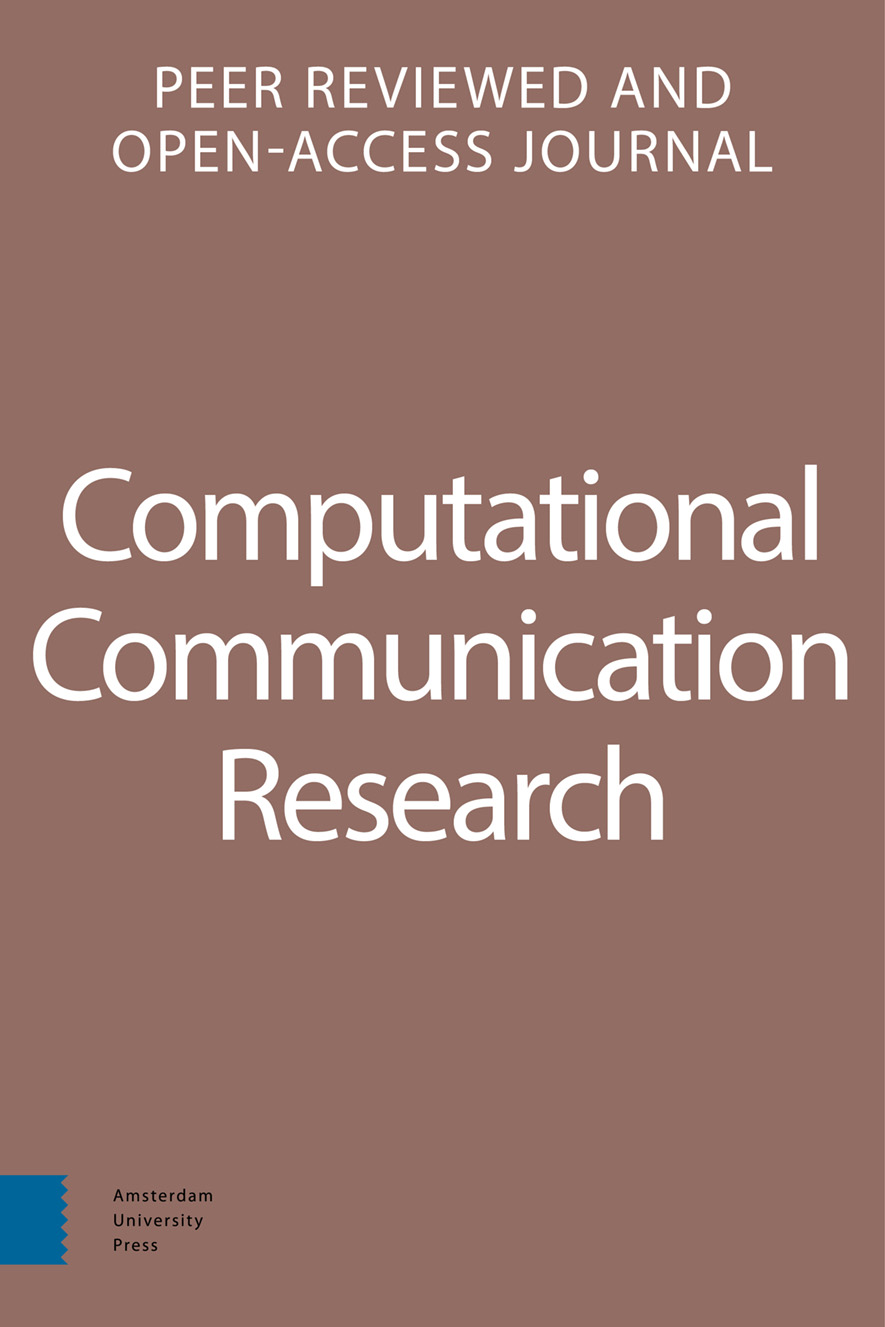- Home
- A-Z Publicaties
- Computational Communication Research
- Previous Issues
- Volume 4, Issue 1, 2022
Computational Communication Research - Volume 4, Issue 1, 2022
Volume 4, Issue 1, 2022
Special Issue: Images as Data
-
-
oa Image as Data: Automated Content Analysis for Visual Presentations of Political Actors and Events
Meer MinderAuteurs: Jungseock Joo & Zachary C. Steinert-ThrelkeldAbstract Images matter because they help individuals evaluate policies, primarily through emotional resonance, and can help researchers from a variety of fields measure otherwise difficult to estimate quantities. The lack of scalable analytic methods, however, has prevented researchers from incorporating large scale image data in studies. This article offers an in-depth overview of automated methods for image analysis and e Read More
-
-
-
oa Visual Framing of Science Conspiracy Videos
Meer MinderAuteurs: Kaiping Chen, Sang Jung Kim, Qiantong Gao & Sebastian RaschkaAbstract Recent years have witnessed an explosion of science conspiracy videos on the Internet, challenging science epistemology and public understanding of science. Scholars have started to examine the persuasion techniques used in conspiracy messages such as uncertainty and fear yet, little is understood about the visual narratives, especially how visual narratives differ in videos that debunk conspiracies versus thos Read More
-
-
-
oa Finding Fauci
Meer MinderAuteurs: Bryce J. Dietrich & Hyein KoAbstract As the Covid-19 pandemic progressed, the public increasingly relied on news outlets to provide up-to-date health information. Often times this information was provided by Dr. Anthony Fauci during the course of on-air interviews. Consequently, when Dr. Fauci appeared less and less, many became concerned that the public was not receiving the full picture, especially since Dr. Fauci was often not afraid to voice concer Read More
-
-
-
oa Age and Gender Representation on German TV
Meer MinderAuteurs: Pascal Jürgens, Christine E. Meltzer & Michael ScharkowAbstract Television offers an enticing glimpse into the world, but its perspective is often skewed. When societal groups are systematically excluded from appearing on the screen, they lose the chance to represent their characteristics and interests. Recipients may then form distorted perceptions and attitudes towards those groups. Empirical research on the prevalence of such biases - especially across stations, time, and genre - h Read More
-
-
-
oa Representations of Racial Minorities in Popular Movies
Meer MinderAuteurs: Musa Malik, Frederic R. Hopp & René WeberAbstract In the Hollywood film industry, racial minorities remain underrepresented. Characters from racially underrepresented groups receive less screen time, fewer central story positions, and frequently inherit plotlines, motivations, and actions that are primarily driven by White characters. Currently, there are no clearly defined, standardized, and scalable metrics for taking stock of racial minorities’ cinematographic represe Read More
-
-
-
oa Body Language and Gender Stereotypes in Campaign Video
Meer MinderAuteurs: Markus Neumann, Erika Franklin Fowler & Travis N. RidoutAbstract We examine the impact of candidates’ gender on the body language that they employ in their political advertisements. Using data on over 1,600 candidates appearing in almost 5,400 political ads that aired in the U.S. between 2017 and 2020, we employ automatic pose detection to trace the movement of their hands. We find, consistent with gender stereotypes, that male candidates use more assertive hand movem Read More
-
-
-
oa MARMOT
Meer MinderAuteurs: Patrick Y. Wu & Walter R. Mebane Jr.Abstract Political activity on social media presents a data-rich window into political behavior, but the vast amount of data means that almost all content analyses of social media require a data labeling step. However, most automated machine classification methods ignore the multimodality of posted content, focusing either on text or images. State-of-the-art vision-and-language models are unusable for most political science Read More
-
-
-
oa Athec
Meer MinderDoor Yilang PengAbstract Visual aesthetics are related to a broad range of communication and psychological outcomes, yet the tools of computational aesthetic analysis are not widely available in the social science community. In this article, I address this gap and provide a tutorial on measuring hand-crafted aesthetic attributes, such as colorfulness and visual complexity. I introduce Athec, a Python library for computational aesthetic analysis i Read More
-
-
-
oa A Character Recognition Tool for Automatic Detection of Social Characters in Visual Media Content
Meer MinderAuteurs: Joshua Baldwin & Ralf SchmälzleAbstract Content analysis is the go-to method for understanding how social characters, such as public figures or movie characters, are portrayed in media messages. It is an indispensable method to investigate character-related media processes and effects. However, conducting large-scale content-analytic studies is a taxing and expensive endeavor that requires hours of coder training and incurs substantial costs. This probl Read More
-
-
-
oa The Pervasive Presence of Chinese Government Content on Douyin Trending Videos
Meer MinderAuteurs: Yingdan Lu & Jennifer PanAbstract As audiences have moved to digital media, so too have governments around the world. While previous research has focused on how authoritarian regimes employ strategies such as the use of fabricated accounts and content to boost their reach, this paper reveals two different tactics the Chinese government uses on Douyin, the Chinese version of the video-sharing platform TikTok, to compete for audience atte Read More
-
Most Read This Month
Article
content/journals/26659085
Journal
10
5
false
nl

Most Cited Most Cited RSS feed
-
-
oa Computational observation
Auteurs: Mario Haim & Angela Nienierza
-
- More Less

